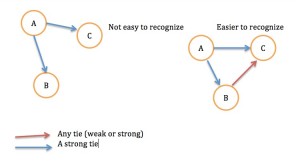Using strong triadic closure to recognize social ties
Throughout its lifetime, the human brain has to store an enormous amount of information. Not only is storing a main activity of the brain, but the ability to recover a certain piece of information from that whole array of data is also a main concern.
Thanks to brain plasticity, or the ability of the brain to change its conformation due the amount of a certain type of knowledge it receives, storing information is facilitated.
To do that, our brain has to store the information is such a way that the recovery is for one, fast, and also accurate. This article is written by Stephanie Pappas, in which the author states a paper that studies exactly how the brain is able to recognize a person based on a principle we learned in class: strong triadic closure.
This article is about Professor Brashears’ work, a Cornell University professor, on how the brain recalls social ties between the people one meets in one’s lifetime. He states that if the brain has to remember each person individually, it would take much more time to get that information from our minds. Instead the brain perceives people’s social ties as a network, and based on the links between different people, recognizes the people one has met. To research the validity of his hypothesis, Brashears asked some people to come into his lab, read about the connections between different people, and then try to remember what the links between those people were. He found out that it was easier to recall someone that was linked to other people by social ties instead of trying to remember someone isolated. Moreover, the results showed that people that were strongly connected to two other people, but that these formers two didn’t know each other were harder to memorize than a person which both close friends are also connected to each other. The illustration below illustrates that statement: 
Learning about how the brain works helps us find new methods to facilitate learning.
This article is related to the notion of strong triadic closure that we learned about in class. It can also be seen as similar to the lecture on Facebook’s study of social ties for friendship suggestions.
